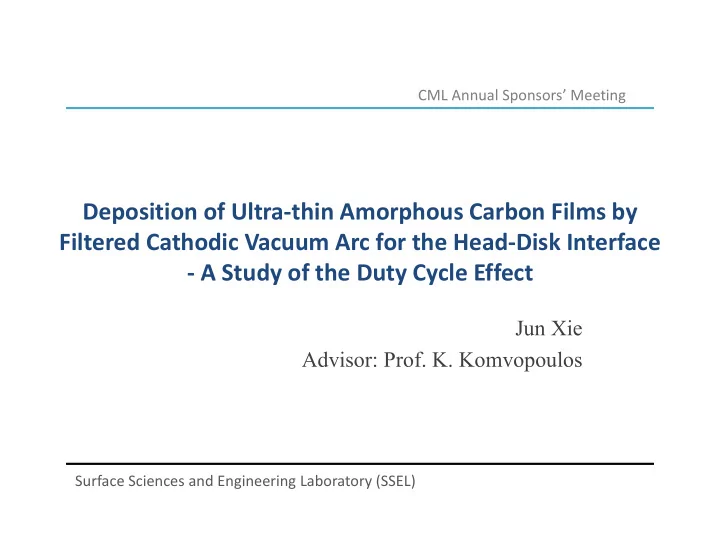

CML Annual Sponsors’ Meeting Deposition of Ultra ‐ thin Amorphous Carbon Films by Filtered Cathodic Vacuum Arc for the Head ‐ Disk Interface ‐ A Study of the Duty Cycle Effect Jun Xie Advisor: Prof. K. Komvopoulos Surface Sciences and Engineering Laboratory (SSEL)
Introduction • Objective – Synthesize ultrathin (<2 nm), smooth and durable amorphous carbon ( a -C) overcoats • Higher storage level with high-quality protective overcoats • Method – Control of deposition parameters • Competition between deposition, implantation and re- sputtering processes results in the modification of film properties
Deposition Method • Filtered Cathodic Vacuum Arc (FCVA) – Energetic C + ion bombardment – Substrate bias voltage controls the ion energy Duty cycle of pulse bias Substrate pulse bias Ion fluence (deposition time or arc current) Incidence angle Ion energy (substrate bias voltage)
Duty cycle of substrate bias 50 % 65 % Defined as the ratio • 0 0 of the pulse-on T on Substrate voltage (V) time to the pulse -50 -50 period T -100 -100 -150 -150 λ = T on / T 0 50 100 150 200 0 50 100 150 200 Off bias 0 0 -50 -50 T o n -100 -100 Negative bias -150 -150 0 50 100 150 200 0 50 100 150 200 Time ( s) T 75 % Duty cycle (%) 95 % Controls the contributions of high- and low-energy FCVA deposition • processes. – high C + ion energy during negative biasing, low C + ion energy during off bias
Film Properties T ‐ DYN (transport range of ions in matter) simulations 1.0 Atomic carbon fraction 0.8 0.6 0% 0.4 50% 65% 75% 0.2 95% 100% 0.0 0 2 4 6 8 10 12 14 Depth (nm) Monte Carlo simulations of binary atom collisions • Computation conditions • Target: silicon & incoming C + ions – Ion energy: -173 eV for pulse-on time and 0 eV for pulse-off time, producing an average – ion energy between 86 eV and 146 eV for duty cycles in the range of 50% to 95%
Film Properties Thickness dependence on duty cycle 14 12 10 Thickness (nm) 8 6 4 Total film thickness 2 Carbon layer thickness Intermixing layer thickness 0 0 20 40 60 80 100 Duty cycle (%) Total thickness: thickness of all channels containing C atoms (0-100 at%) • Carbon layer: C atom fraction > 85 at% • Thickness of intermixing layer: C atom fraction 5-85 at% • More C + implantation and less deposition with the increase of the duty cycle •
Film Properties Surface topography 0.140 Deposition Roughness (nm) dominated 0.135 0.130 Ion sputter etching dominated 0.125 Balance between deposition and sputtering 0.120 50 60 70 80 90 100 Duty cycle (%) The film surface roughness was determined from 2 × 2 μ m 2 surface area • images obtained with the AFM Roughness is influenced by deposition and sputtering process effects •
Film Properties Raman measurement G • Methods D Duty cycle – Gaussian fit of D and G peaks 50% Intensity (a.u.) • Shape features 65% – G peak FWHM – G peak position 75% – I(D) / I(G) ratio 95% 1200 1400 1600 1800 -1 ) Wavenumber (cm • Dependent factors – sp 2 cluster size – Bond length/angle disorder – sp 2 /sp 3 ratio D peak - Breathing mode G peak - Stretching mode
Film Properties Raman measurement 1.2 230 D-to-G peak intensity ratio 220 1.0 -1 ) G peak FWHM(cm 210 0.8 200 0.6 190 0.4 180 0.2 50 60 70 80 90 100 50 60 70 80 90 100 Duty cycle (%) Duty cycle (%) • Decrease of I(D)/I(G) • Increase of G peak FWHM - shows a decrease in - shows a decrease in sp 2 cluster size sp 2 cluster size • • sp 2 ordering •
Film Properties Raman measurement VS stress relation -7 1580 G peak position Internal stress -8 1575 -1 ) Internal stress (GPa) G peak position (cm Excessive sputtering 1570 -9 and thermal spikes 1565 Increased ion Increased ion -10 implantation 1560 -11 1555 1550 -12 50 60 70 80 90 100 Duty cycle (%) Downward shift of G peak position • – shows a decrease in – shows an increase in sp 2 cluster size and ordering • sp 3 fraction • linear chain length • • internal compressive sp 2 fraction stress • The internal stress σ f is measured by curvature method •
Film Properties TEM cross ‐ sectional sample Tecnai CM200 Cross-sectional HRTEM images STEM • • • specimen EELS •
Film Properties TEM image Deposition condition intermixing layer thickness: 4.4 nm • • 95% duty cycle a -C film thickness: 14.9 nm • • 30 s deposition time total thickness: 19.3 nm • •
Conclusions The duty cycle has a significant effect on the film properties • (controls the competing effects of deposition and sputtering). The thickness of the a -C film and the intermixing layer increase • with the increase of the duty cycle A 65% duty cycle yields the lowest roughness, whereas a 75% duty • cycle yields the highest compressive stress and sp 3 fraction, smallest sp 2 cluster size, less bond ordering, and lowest sp 2 fraction Future Work Investigation of cross-sectional EELS spectra of a -C films for • different duty cycles aimed at further reducing the thickness while preserving the protective film properties (e.g., high sp 3 fraction) Comparison of sp 2 and sp 3 hybridizations of a -C films obtained from • cross-sectional EELS analysis with the overall film composition obtained by XPS Investigation of the duty cycle effect on the thermal stability of • FCVA-deposited a -C films
Thanks!
Recommend
More recommend